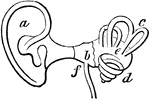Clipart tagged: ‘cohlea’

Ear
Interior of the ear. There is external to the head a wide-mouthed tube, or ear-trumpet (a), for catching…

Interior of the ear. There is external to the head a wide-mouthed tube, or ear-trumpet (a), for catching…